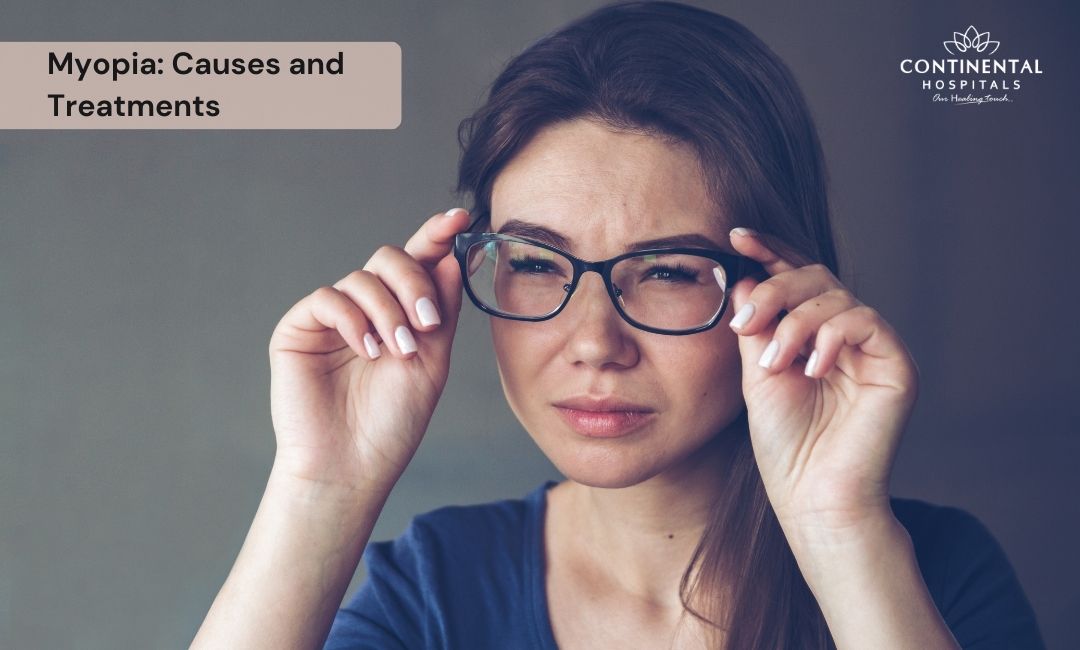Myopia, also commonly known as nearsightedness, is a widespread vision condition that affects millions of people globally. It presents a hurdle in seeing distant objects clearly, while near objects remain sharp. This can make everyday activities like driving, reading road signs, or watching a movie on the big screen quite blurry and challenging.
This blog delves into the world of myopia, exploring its causes, symptoms, diagnosis, and the various treatment options available. By understanding myopia, you can take charge of your vision health and ensure you see the world clearly, both near and far.
What is Myopia and How Does it Affect Vision?
Myopia occurs due to an irregularity in the shape of the eyeball. Ideally, the eyeball should be round, allowing light rays entering the eye to focus precisely on the retina, a light-sensitive layer at the back of the eye. In myopic individuals, the eyeball is either elongated or the cornea (the clear dome at the front of the eye) is too curved. This causes light rays to converge before reaching the retina, resulting in blurry distant vision.
The degree of myopia can vary. Mild cases might only cause slight haziness in distant vision, while severe myopia can make even nearby objects appear unclear.
If you experience persistent or severe eye strain, it's a good idea to consult with an Eye care specialist for a comprehensive eye examination to rule out any underlying eye conditions.
Common Symptoms of Myopia
Here are some telltale signs that you might have myopia:
- Difficulty seeing distant objects clearly, like road signs, billboards, or people across the room.
- Squinting to try and focus on distant objects.
- Headaches caused by eyestrain from squinting.
- Seeing near objects clearly.
If you experience any of these symptoms persistently, it's crucial to schedule an appointment with an eye doctor for a comprehensive eye exam. Early detection and diagnosis of myopia are essential for obtaining proper vision correction and preventing potential complications.
Causes of Myopia
The exact cause of myopia remains under investigation, but research suggests a combination of genetic and environmental factors play a role:
Genetics: Myopia tends to run in families. If one or both parents are nearsighted, you have a higher chance of developing it.
Increased Near Work: Extensive near work activities like reading, using computers, or playing video games for prolonged periods have been linked to myopia, particularly in children.
Reduced Outdoor Time: Studies suggest that spending less time outdoors, particularly during childhood, might be a contributing factor. Sunlight exposure is believed to play a role in the healthy development of the eye.
Ethnicity: Certain ethnicities, including East Asians, appear to have a higher prevalence of myopia.
Diagnosis of Myopia
A comprehensive eye exam conducted by an ophthalmologist (eye doctor) is the standard procedure for diagnosing myopia. The exam typically involves:
Visual Acuity Test: This familiar eye chart test measures your ability to see objects at various distances, helping determine the severity of your myopia.
Retinoscopy: This painless test uses a light instrument to assess how light reflects from your retina, providing information about your eye's focusing power.
Slit-Lamp Examination: The doctor uses a specialized microscope with a bright light to examine the structures of your eye, including the cornea, lens, and retina.
Based on the examination results, your eye doctor will determine your prescription for corrective lenses.
Treatment Options for Myopia
Fortunately, myopia is a highly treatable vision condition. Here are the most common treatment options:
Eyeglasses: Eyeglasses with corrective lenses are the most common and traditional method for correcting myopia. The lenses are designed to bend light rays entering the eye, focusing them precisely on the retina and providing clear vision.
Contact Lenses: Contact lenses are thin, curved plastic discs that fit directly on your cornea. They work similarly to eyeglasses by correcting the focusing of light rays. Soft contact lenses are a popular choice for many people with myopia.
Orthokeratology (Ortho-K): This non-surgical approach involves wearing specially designed rigid gas-permeable contact lenses overnight. These lenses gently reshape the cornea temporarily, improving your vision during the day while you don't wear them.
Refractive Surgery: For individuals who prefer a long-term solution and meet specific criteria, refractive surgery can be considered. LASIK (Laser-Assisted in Situ Keratomileusis) is a common type of refractive surgery that uses a laser to reshape the cornea, permanently correcting myopia.
The best treatment option for you will depend on your specific needs, lifestyle, and the severity of your myopia. It's essential to discuss all the options with your eye doctor to determine the most suitable approach for you.
Myopia is a prevalent visual condition influenced by a combination of genetic and environmental factors. Understanding the causes of myopia is essential for implementing preventive measures and selecting appropriate treatment options. While corrective lenses offer immediate relief, advanced treatments such as orthokeratology and refractive surgery provide long-term solutions for managing myopia. Consulting an eye care professional is crucial for personalized assessment and guidance on the most suitable treatment approach based on individual needs and lifestyle factors. By staying informed and proactive about eye health, individuals can effectively manage myopia and enjoy clear vision for years to come.
If you experience persistent or severe eye strain, it's a good idea to consult with an Eye care specialist for a comprehensive eye examination to rule out any underlying eye conditions.
Related Blog Articles:
1. Screen Time and Children's Mental Health: Finding a Balance
2. Tips for Preventing Computer Vision Syndrome in Children and Adults
.webp)







